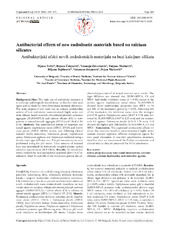Приказ основних података о документу
Antibacterial effects of new endodontic materials based on calcium silicates
Antibakterijski efekti novih endodontskih materijala na bazi kalcijum silikata
| dc.creator | Trišić, Dijana | |
| dc.creator | Ćetenović, Bojana | |
| dc.creator | Zdravković, Nemanja M. | |
| dc.creator | Marković, Tatjana | |
| dc.creator | Dojčinović, Biljana P. | |
| dc.creator | Jokanović, Vukoman R. | |
| dc.creator | Marković, Dejan | |
| dc.date.accessioned | 2020-01-20T12:46:30Z | |
| dc.date.available | 2020-01-20T12:46:30Z | |
| dc.date.issued | 2019 | |
| dc.identifier.issn | 0042-8450 | |
| dc.identifier.uri | https://vinar.vin.bg.ac.rs/handle/123456789/8426 | |
| dc.description.abstract | Background/Aim. The main task of endodontic treatment is to eliminate pathologically altered tissue, to disinfect root canal space and to obtain its three-dimensional hermetic obturation. The main purpose of this study was to evaluate antimicrobial activity of new endodontic nano-structured highly active calcium silicates based materials albo-mineral plyoxide carbonate aggregate (ALBO-MPCA) and calcium silicates (CS) in comparison to mineral trioxide aggregate (MTA+) and UltraCal XS (CH). Methods. The antimicrobial activity of materials was tested against Staphylococcus aureus (ATCC 25923) and Enterococcus faecalis (ATCC 14506) strains, and following clinical isolates: Rothia dentocariosa, Enterococcus faecalis, Staphylococcus aureus, Streptococcus anginosus and Streptococcus vestibularis using a double layer agar diffusion test. The pH measurements were performed using the pH meter. Total amount of released ions was determined by inductively coupled plasma optical emission spectrometry (ICP-OES). Results. All tested materials showed the best antibacterial potential after 1 h of incubation. After 3h and 24h of the incubation period, the antibacterial potential of all tested materials were similar. The Agar diffusion test showed that ALBO-MPCA, CS and MTA+ had similar inhibition zones (p > 0.05), except in the activity against Staphylococcus aureus where ALBO-MPCA showed better antimicrobial properties than MTA+ in 3h and 24h of the incubation period (p < 0.05). Following 24h of the incubation, the inhibition zones were the strongest with CH against Staphylococcus aureus (16.67 ± 2.34 mm) followed by ALBO-MPCA (14.67 ± 1.21 mm) and the weakest with CS against Enterococcus faecalis (6.50 ± 1.76 mm). CH showed the highest pH, followed by ALBO-MPCA, CS and MTA+. Conclusion. The expressed antibacterial effects indicate that materials based on nano-structured highly active calcium silicates represent effective therapeutic agents for root canal obturation in one-visit apexification treatment, therefore they are recommend for further examination and clinical trials as they are proposed for MTA substitution. © 2019, Inst. Sci. inf., Univ. Defence in Belgrade. All rights reserved. | en |
| dc.language.iso | en | |
| dc.relation | info:eu-repo/grantAgreement/MESTD/Basic Research (BR or ON)/172026/RS// | |
| dc.relation | info:eu-repo/grantAgreement/MESTD/Technological Development (TD or TR)/31079/RS// | |
| dc.rights | openAccess | |
| dc.rights.uri | https://creativecommons.org/licenses/by-sa/4.0/ | |
| dc.source | Vojnosanitetski pregled | |
| dc.subject | dental pulp diseases | en |
| dc.subject | root canal preparation | en |
| dc.subject | calcium silicate | en |
| dc.subject | calcium hydroxide | en |
| dc.subject | anti-infective agents | en |
| dc.title | Antibacterial effects of new endodontic materials based on calcium silicates | en |
| dc.title.alternative | Antibakterijski efekti novih endodontskih materijala na bazi kalcijum silikata | sr |
| dc.type | article | en |
| dc.rights.license | BY-SA | |
| dcterms.abstract | Тришић, Дијана; Ћетеновић, Бојана; Марковић, Татјана; Јокановић, Вукоман; Здравковић, Немања; Дојчиновић, Биљана; Марковић, Дејан; | |
| dc.rights.holder | © 2019, Inst. Sci. inf., Univ. Defence in Belgrade | |
| dc.citation.volume | 76 | |
| dc.citation.issue | 4 | |
| dc.citation.spage | 365 | |
| dc.citation.epage | 372 | |
| dc.identifier.wos | 000504432700002 | |
| dc.identifier.doi | 10.2298/VSP161231130T | |
| dc.citation.rank | M20 | |
| dc.type.version | publishedVersion | |
| dc.identifier.scopus | 2-s2.0-85069738071 | |
| dc.identifier.fulltext | https://vinar.vin.bg.ac.rs/bitstream/id/20928/0042-84501700130T.pdf |
Документи
Овај документ се појављује у следећим колекцијама
-
Radovi istraživača
Researchers' publications

